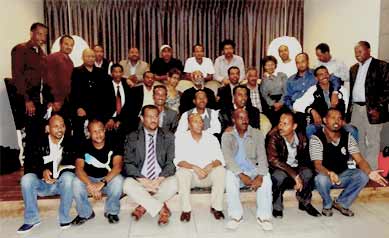Power, Image, and Machiavellian Survival: Emperor Haile Selassie and President Isaias Afwerki

Two Towering Figures–Giants and Lilliputians (Part 1)
Across the sorrowful and entangled histories of Ethiopia and Eritrea, two figures loom with spectral intensity: Emperor Haile Selassie I and President Isaias Afwerki. Their shadows stretch across generations, ideologies, and geopolitical fault lines—each a master of power, each a paradox incarnate. At the outset of their reigns, both men embodied the loftiest aspirations of their nations: Haile Selassie as the herald of African sovereignty and imperial modernity; Isaias as the vanguard of liberation and self-reliance. Yet by the twilight of their rule, each had come to symbolize the very disillusionment they once vowed to overcome—the erosion of promise, the entrenchment of control, and the betrayal of popular hope.
While Meles Zenawi occupies a place in the constellation of consequential leaders, this essay sets him aside. Nonetheless, circumstantial evidence suggests that Isaias Afwerki regarded Meles as a junior partner—perhaps even a protégé—only to witness the student surpass the teacher. That asymmetry quietly shaped their strategic choreography. Meles, for his part, did not live long enough to leave a generational imprint. He died at 57, his legacy truncated before it could fully mature. In the years since, his successors—most notably the current prime minister—have appeared intent on erasing his influence, as if engaged in a quiet campaign of political exorcism.
By contrast, Haile Selassie and Isaias Afwerki commanded the political landscapes of their nations for nearly three-quarters of their long lives. In regimes marked by rupture, reinvention, and relentless upheaval, such endurance renders them impossible to ignore.
According to 2021 data from the World Bank, life expectancy in Eritrea and Ethiopia stood at 63.6 and 67.8 years, respectively. Both Haile Selassie and Isaias Afwerki not only outlived their retirement ages but exceeded the average lifespan of their citizens—an irony not lost in systems defined by scarcity, siege, and sacrifice. In Eritrea, nearly two-thirds of the population lives below the poverty line, and the country ranks among the lowest globally in doctor-to-patient ratios. To this, add the thousands of national service conscripts who died young in Isaias’s many and unending wars—lives extinguished before they could even begin to shape a future. These stark disparities underscore the profound dissonance between the longevity of rulers and the lived realities of their people—a contrast that deepens the symbolic weight of their extended reigns and the moral reckoning they invite.
Though separated by time and ideology, Haile Selassie and Isaias each mastered the choreography of power—through image, manipulation, fear, and control. Their physical stature and governing styles mirrored not just the terrain they ruled, but the ambitions and anxieties that shaped their regimes. If the towering 6’3” frame of Isaias and the diminutive 5’1” figure of Haile Selassie evoke the absurd pairing of Schwarzenegger and DeVito in the 1988 film Twins, you’re not alone. That was precisely the image that flickered in my mind when I began writing this piece. But beneath the comic juxtaposition lies a deeper allegory.
Their reigns echo the surreal dimensions of Gulliver’s Travels: Haile Selassie’s Ethiopia, a Lilliputian realm where ceremonial grandeur masked insecurity; Isaias’s Eritrea, a Brobdingnagian dominion where revolutionary mythos concealed a siege mentality and shrinking legitimacy. Each ruler weaponized paradox—turning size into symbolism, isolation into sovereignty, and grievance into governance.
Haile Selassie cloaked imperial fragility in the robes of divine right and global diplomacy, projecting Ethiopia as both ancient and exceptional. Isaias, by contrast, draped revolutionary austerity in the rhetoric of self-reliance and siege, casting Eritrea as a fortress of defiance and fierce independence. One ruled with the elegance of a courtier—ceremonial, elusive, and steeped in protocol; the other with the severity of a guerrilla commander, at times indistinguishable from a warlord. Yet both understood the theater of power: how to stage presence, script loyalty, and choreograph fear with precision. Their authority was not merely enforced—it was performed.
Their bodies became metaphors for their states—one compact, refined, and ceremonial; the other elongated, ascetic, and austere. Their legacies, though divergent, converge in a shared mastery of illusion: the ability to make smallness seem grand, and grandeur seem invincible.
Machiavellian Instincts: Crafting Power Through Image
Haile Selassie, robed in imperial mystique, projected Ethiopia as an ancient empire reborn—an African exception in a colonial world. Isaias, austere and elusive, fashioned Eritrea as a revolutionary nation, defined by defiance yet increasingly marked by isolation and control. Beneath their contrasting veneers lay a shared Machiavellian instinct—honed in the crucible of court intrigues, liberation wars, foreign interventions, and the ever-present specter of betrayal.
Both understood that power is never simply held—it must be staged, ritualized, and relentlessly performed. Despite ideological differences, their regimes converged in practice: myth-making, silencing dissent, and manipulating historical memory. In this way, Haile Selassie and Isaias were not merely rulers, but dramaturges of national identity—authors who crafted, revised, and sometimes erased entire chapters to serve the imperatives of survival, supremacy, and self-mythologization.
Isaias Afwerki’s Transformation: A Revolution’s Single Vision
What continues to astound me is the extent to which the EPLF—and by extension, the post-independence Eritrean state—has been sculpted in the image of Isaias Afwerki. A movement that once stood for collective sacrifice, ideological pluralism (at least in theory), and generational heroism now, in retrospect, resembles a stage for the consolidation of a single man’s vision. The very giants—commanders, cadres, martyrs—whose names once stirred reverence now appear increasingly repurposed as instruments in a narrative of personal aggrandizement.
This transformation is not easy to accept. It conflicts with the reverence I hold for those who sacrificed everything for Eritrea’s liberation. Yet, the evidence is undeniable: the centralization of power, the erasure of dissent, and the rewriting of revolutionary history to elevate one figure above the collective. The EPLF’s vast reservoir of courage and intellect now seems distilled into a single persona—Isaias as strategist, savior, and sole custodian of the national story.
Uncomfortable Questions: Was the Revolution Truly Plural?
This transformation invites difficult questions: Was the revolution ever truly plural? Were its heroes celebrated only to be discarded once their symbolic utility expired? And what does it mean for a nation when its founding myth becomes indistinguishable from the ambitions of one man? These questions do not diminish the valor of those who fought, but they demand a reckoning with the architecture of power that emerged from their struggle—a power that is performed through control, myth, and the selective memory of history.
The Emperor: A Figure of Sacred Legitimacy and Political Cunning
Haile Selassie, diminutive in height at barely five feet one inch, carried himself with the gravity of a monarch convinced of his divine mandate. His piercing gaze, meticulous grooming, and regal attire conveyed not only authority but sacred legitimacy. Every detail of his appearance was deliberate: uniforms heavy with medals, posture unwavering, expression serene yet unreadable. Raised in Ethiopia’s royal court amid tribal rivalries and feudal intrigue, Haile Selassie learned early that survival demanded intelligence cloaked in subtlety. Surrounded by nobles who rose and fell through conspiracies, he became a master of calculated restraint.
His Machiavellian instincts—manipulating rivals, rewarding loyalty only when expedient, and suppressing threats under the guise of divine order—were sharpened in this courtly arena. In his world, mercy was weakness, and secrecy, strength.
The Emperor’s Ambitions: Power Beyond the Empire
Haile Selassie’s ambitions mirrored his cunning. Though he presided over one of Africa’s largest empires, he was never content with its borders. Like the vain monarchs of Lilliput, he sought to appear larger than life by expanding his dominion—dreaming of annexing Somalia, Djibouti, and Eritrea in pursuit of an imperial destiny that would engulf the entire Horn of Africa. His physical smallness became emblematic of a deeper psychological hunger: a sovereign who saw himself as a divine giant trapped in a mortal frame.
The vastness of his realm could not quench his thirst for historical immortality. His mastery of appearances—crowned in ceremony, cloaked in diplomacy—masked the fragility of a ruler perpetually haunted by rebellion and betrayal. And now, what is even more troubling: the so-called Seventh King appears determined to resurrect Haile Selassie’s dreams—and with them, the nightmares of everyone else.
Haile Selassie’s Political Artistry: Cruelty and Mercy in Balance
Robert Greene, author of The 48 Laws of Power and The Laws of Human Nature, praises Haile Selassie as a virtuoso of political artistry—one who blended vice and virtue with surgical precision. Haile Selassie understood that power endures not through brute force alone but through a strategic balance of cruelty and magnanimity. One striking example was his handling of Balcha Safo, a formidable regional warlord who defied imperial authority. Rather than annihilate Balcha’s forces, Haile Selassie outmaneuvered him politically, defeated his army without bloodshed, and then built a hospital in his honor—Balcha Hospital in Addis Ababa. In doing so, he eliminated a rival and immortalized him as a symbol of imperial benevolence. This exemplifies Greene’s principles: Haile Selassie’s cruelty was purposeful, his mercy political.
Isaias Afwerki: A Brutal Imitation of Power
Isaias Afwerki, by contrast, stands as a brute philistine—an imitator of power without refinement. He understands coercion but not magnanimity. His cruelty is rarely strategic; it is often vindictive, personal, and corrosive. A chilling example is the imprisonment of Weyzero Aster Yohannes, wife of Petros Solomon, Eritrea’s former Foreign Minister and a key architect of the Eritrean People’s Liberation Front (EPLF). Aster returned voluntarily from the United States to reunite with her children, only to be imprisoned indefinitely without trial or explanation. Her only crime was loyalty to a man who once stood shoulder to shoulder with Isaias during the liberation struggle and her desire to be with her children, who were left fatherless. (It is true that the late Ambassador Girma Asmerom not only encouraged Aster Yohannes to return, but personally assured her that nothing would happen to her. Many have since accused him of complicity in her imprisonment. I have reason to believe, however, that Ambassador Girma exhausted every avenue to secure her release, only to be silenced by threats to his own safety. He died heartbroken, and it remained one of his deepest regrets.
I never liked Girma Asmerom—I found him pretentious and bombastic. But I have a moral obligation to stand for the truth. Those who have maligned his name should withhold their judgment until we know the whole truth—and nothing but the truth.)
Even more tragically, Isaias’s cruelty has extended to the families of those who fled his regime. Chiam Ali, the teenage daughter of Ali Abdu—Eritrea’s former Minister of Information—was barred from leaving the country after her father defected and has been missing since 2012. Whenever I think of Chiam, I struggle to hold back tears. She is the same age as my first-born, who is now completing his medical residency—while she has spent nearly half her life behind bars. I cannot begin to fathom the scope or severity of such cruelty.
I rarely meet anyone who speaks favorably of Ali Abdu—the man who flattered Isaias through mimicry so sincere it bordered on self-erasure. But what does that have to do with his innocent daughter, Chiam Ali? Her suffering is not his crime. She should have been freed long ago. And even now, I say: let her go.
She is no longer merely Ali Abdu’s daughter. She is every Eritrean’s daughter—a symbol of stolen youth, of injustice prolonged, and of the quiet dignity that survives even behind prison walls.
At one point, the late Aboy Abdu was imprisoned alongside his son and granddaughter—three generations of the Inda Aboy Abdu family ensnared by a regime that punishes bloodlines for what appears to be dissent or mere non-conformity. No charges were filed. No explanations offered. The government remains silent—not only about their incarceration, but about the fate of the disappeared more broadly. And in this context, silence is not merely bureaucratic—it is a form of violence. It erases lives, severs lineage, and turns memory itself into a contested terrain.
Chiam’s vanishing shocked the diaspora and laid bare the regime’s willingness to target the innocent as proxies for political revenge. These are not merely abuses of power—they are violations of the most basic human bonds. Such acts defy not only reason but the very essence of humanity, revealing a system so consumed by paranoia that it devours its own children.
Isaias has become the Eritrean version of Ivan the Terrible: a ruler whose paranoia and vindictiveness have turned governance into a theater of repression, where even familial ties are criminalized and mercy is treated as weakness.
The Destructive Pattern: Power Without Vision
In contrast to Haile Selassie’s calculated blend of mercy and manipulation, Isaias’s power is untempered and self-destructive—a pattern of brutality that earns no loyalty, commands no respect, and serves no enduring purpose. His cruelty, unanchored by any vision of greatness or national renewal, corrodes both ruler and nation. What remains is not strength, but a hollow performance of control—sustained by fear and destined to collapse under the weight of its own inhumanity.
To be continued:
To contact the author: weriz@yahoo.com




Awate Forum